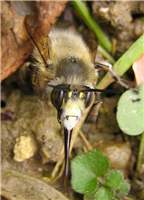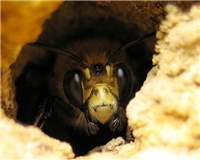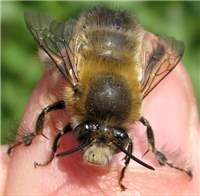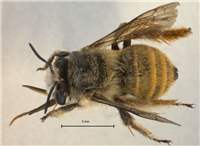Species in the Genus
Species in Kenya, Tanzania & Uganda
Description
Possible Causes of Confusion
Distribution in Kenya, Tanzania & Uganda
Habitats
Nesting
Crops Visited
Other Plants Visited
Economic / Ecological Importance
Threats
Conservation and Management Practices
Legislation (National and International)
References
Editors
Acknowledgements
Contact
Click on images to enlarge

Anthophora fulvitarsis. Photo by Ferran Turmo Gort (CC BY-NC-ND)

Anthophora plumipes female. Photo by Ombrosoparacloucycle (CC BY-NC-SA)

Anthophora plumipes. Photo by Ombrosoparacloucycle (CC BY-NC-SA)

Anthophora plumipes. Photo by Nigel Jones (CC BY-NC-ND)

Anthophora vestita (female) - pinned specimen. Photo: Connal Eardley

Anthophora vestita (male) - pinned specimen. Photo: Connal Eardley
Summary
Honey bees are not the only bee species that are significant for human wellbeing. Anthophora bees are a group of native bee species that do not produce honey but are important pollinators of crops and wild plants. Anthophora bees are not aggressive but can sting for defence. Individuals are large often with yellow facial markings and some Anthophora species have distinctive bands. Individuals make nests in the soil and live independently of others (i.e. they are solitary), although nests can be close together. This fact sheet provides information about these bees to encourage farmers to understand and protect them to help ensure that their crops are effectively pollinated.
From a conservation and agricultural standpoint it is not necessary to recognise all the different bee genera. However, it is important to know that there is a large bee biodiversity. Different bee genera pollinate different plant species, although there is some overlap that acts as a buffer as bee populations wax and wane. For healthy ecosystems, including agro-ecosystems both diversity and abundance in the bee fauna is important.
Scientific Classification
Kingdom: Animalia
Phylum: Arthropoda
Class: Insecta
Order: Hymenoptera
Family: Apidae
Subfamily: Apinae
Tribe: Anthophorini
Genus: Anthophora Latreille, 1802
Species in the Genus
Anthophora is one of the largest genera in the bee family Apidae, with over 450 known species worldwide. They are most abundant and diverse in the northern temperate and African regions.
Species in Kenya, Tanzania & Uganda
The bee species belonging to the genus Anthophora are widespread in sub-Saharan
Description
In East Africa Anthophora bees are not well known by local people (including farmers) in East Africa, where the name bee is generally thought only to apply to honey bees. However, many local people who see Anthophora bees at flowers will possibly know that they are bees but think that they are honeybees. These large, heavy and beautiful bees can be easily identified by their size and colour characteristics. Most Anthophora species have yellow facial markings though some have black faces. The bodies of commonly encountered bees in the field are yellow-white or blue-white in colour.
Possible Causes of Confusion
Some other bee groups look like Anthophora bees: These are large Amegilla, Xylocopa, Megachile, Tetraloniella, Tetralonia, and Melitta bees. While foraging on various plant species, males of Xylocopa can sometimes look like Anthophora bees. Anthophora individuals can be distinguished from the very similar genus Amegilla by the possession of arolia (sticky pads) between their claws.
Distribution in Kenya, Tanzania & Uganda
Anthophora bees are found in most districts/regions of
Habitats
Anthophora bees can be found in various habitats (land-uses) in East Africa such as grasslands, natural forests, wetlands, marshlands, open habitats, protected areas, farmlands, rangelands, woodlands, woodlots (forest plantations), riparian areas.
Nesting
All Anthophora species are solitary, though nests may be found close together. Many species make nests in the soil (Michener 2007).
Crops Visited
Most Anthophora species in appear to collect nectar and pollen from a wide range of flowering crop species belonging to different plant families although a few species appear to be specialised, mostly visiting plant species from one family. These bees are efficient pollinators of crops such, water melon, coffee, beans, cowpeas, Bambara nuts, simsim (sesame), passion fruits, and apples.
Other Plants Visited
In
Economic / Ecological Importance
Little information exists on the usefulness of these bees to the lives of the people in
Threats
In
Conservation and Management Practices
There are now concerted research efforts in the region to develop best practices for conservation and management of bees to enhance crop production. Theoretically, bee conservation and management is inexpensive and adopted activities can also improve the aesthetic value of the landscape. Such practices involve setting land aside (e.g. a 1-metre strip) in the farmland to host all year round food resources for the bees, as well as safer sites for nesting, mating, resting and hiding from natural enemies. During flowering, farmers should manage pesticide usage carefully to avoid poisoning flower-visiting bees. Farmers should also minimise pesticide drift from the field to adjacent areas. Laws governing registration and use of plant protection products also indirectly play a major role in the protection of pollinators. Wood collection should be managed to conserve the nesting sites wood-nesting species and trampling by people and livestock and tilling should be managed to conserve the nesting sites of soil-nesting species. KARI (the Kenya Agricultural Research Institute) is developing protocols for mass rearing of different species of solitary bees. Any successful results from this research will be freely communicated to the public. In addition, KARI is collaborating with other stakeholders to ensure in situ conservation and management of bees for pollination purposes. Much of the work of conserving native bees will be underpinned by raising public awareness of the importance of these species.
Legislation (National and International)
There is not yet any legislation in
References
1. Eardley CD, Gikungu MW and Schwarz MP (2009) Bee conservation in Sub-Saharan Africa and
2. Eardley CD, Kuhlmann M and Pauly A. (2010) The Bee Genera and Subgenera of sub-Saharan
3. Eardley CD and Urban R (2010) Catalogue of Afrotropical bees (Hymenoptera: Apoidea: Apiformes). Zootaxa, 2455: 1–548.
4. Michener CD (2007) The Bees of the world, the John Hopkins University Press,
5. Eardley, CD and Brooks RW (1989) The genus Anthophora Latreille in southern
Editors
Théodore Munyuli, Busitema University - Uganda; Muo Kasina, Kenya Agricultural Research Institute (KARI) - Kenya; Juma Lossini, Tropical Pesticides Research Institute (TPRI) – Tanzania; John Mauremootoo, BioNET-INTERNATIONAL Secretariat – UK; Connal Eardley, Plant Protection Research Institute (PPRI) – South Africa.
Acknowledgements
We recognise the support from the Kenya Agricultural Research Institute (KARI), Tropical Pesticide Research Institute (TPRI) –
Contact
BioNET-EAFRINET regional coordinator: [email protected]












